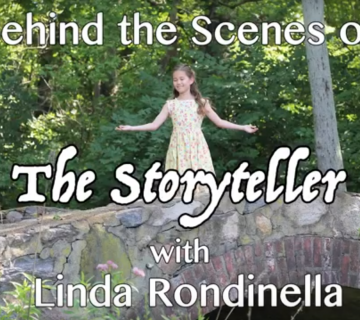Continuing our complete filmmaking series, following the production of The Storyteller, a feature film by Joe Crump and Rachel Noll, we’re now taking a closer look at film financing – in two parts. The first part will be a ‘Film Financing 101′ to get the vocabulary down, then the second part will be a case study based on The Storyteller. Be sure to read both.
Whether transporting us to Mars, sending us to school at Hogwarts or putting us in a dystopian future where we must fight for our lives, a story is only limited by how far the writer’s imagination can take them. However, in the filmmaking world, there is a limitation that exists for all films, studio blockbusters and indies alike: The Budget.
Now, a budget isn’t just saying, “I have this amount of money… let’s go make a film!” On its most basic level, a budget outlines every element that goes into the film and determines how the money is going to be divided amongst those different elements.
When creating a budget the Producer, Line Producer and/or Filmmaker will sit down with the script and literally go through every line (hence the name Line Producer) and calculate how much money each element of the script will cost. How many locations, what kind of costumes and art direction is needed? Are you going to spend more on a location that needs little dressing but is going to need more shooting days OR are you going to rent a studio and build the location in-house? These are creative questions that are dependent on your budget.
It’s important to remember that the size of the budget directly corresponds to the expectations for the film. Simply put – a higher budgeted movie needs to make more money.
Story before budget or budget before story? It’s the chicken or the egg, but for filmmakers who plan on producing the story they write, being aware of your budget, as you are writing the script is important. You have an idea of what your budget will be and what you are capable of producing with that budget. Also, when you begin looking for financing, your budget and script will act as a package that will help convince investors to invest. They can read your script and know exactly how much you need and why.
When drafting your film’s budget you need to go through every stage: pre-production, production and post-production, as well as marketing and distribution. Think of it this way: The budget allows you to see the lifecycle of your film before it’s even been made.
Do not let the thought of having a small budget make you think that you can’t come up with an interesting story. In fact, budget constraints can fuel the imagination.
Take a look at the trailer for this movie that was made for only $60,000 and was one of the biggest hits of 1999 (the same year The Matrix came out)
So now that we know what a budget is and why it’s important, let’s go into some of the ways that you, the Filmmaker, can finance your film.
#1. Self Finance, aka put it on plastic (the Kevin Smith approach) – Every filmmaker knows this story. You take the money you were going to spend going to film school and instead put it into making a film, or perhaps you put it on credit cards and hope the movie makes enough money to pay them back.
As an example, take Clerks. Kevin Smith’s first film was made this way with a total budget just over $27,000 dollars. When the film went to Sundance, Miramax bought it.
There are benefits to this option – if it’s your money that’s financing the project then the film is completely in your hands. The negative is that there’s a higher risk of not making your money back.
If personal investment is the option you choose to pursue, I would highly recommend creating a Limited Liability Company (LLC) for the production. An LLC protects its investor(s) from any loss incurred during the making of the film – you’re only responsible for the money put into the LLC. LLCs also have tax benefits and are free from governed rules in regards to shareholder and company decisions. Basically, you’ll be able to have more control over the decisions taken in the creation of the film and be more protected should there be problems during production.
#2. Equity – Similar to self-investment, this is when you have a number of investors (be it friends, rich cousins or private investors) that also invest hard cash into the film. When they invest the hard cash, they are buying equity in the film.
It’s important to note that this option requires an LLC structure and that investors must be paid back their original investment plus 20% before profit can be calculated.
Want to know more about LLCs? Check out this article on why LLCs are good for filmmakers.
#3. Crowdfunding – This option differs from the Equity option because people aren’t buying into or investing in your film, they are donating to it. Yes, filmmakers can offer a tier structure a la donate $5 you get a thank you, $10 you get this and so on, but they are not required to pay that money back, like it is the case with equity financing.
The trick with crowdfunding becomes creating a campaign that garners attention and raises enough money. Remember, crowdfunding sites likes Kickstarter take a cut of the raised funds. It’s their payment for giving you a platform to collect donations. In addition, campaigns that don’t raise their goal amount do not keep the money they raised. These are important facts to realize when you are not only creating your budget, but also when you’re deciding your target crowdfunding goal. Can you risk time and money creating a crowdfunding campaign when there’s no guarantee your film will end up getting financed? What will you do if the crowdfunding campaign doesn’t meet its goal?
#4. Pre-Sales – Pre-sales are related to distribution and they can be your best asset in both financing your film and finding private investors. Basically you are making an agreement for where and how the film with be distributed before it has even been made. The amount your film is sold for is based on the package you, the filmmaker, has created: your script, the talent attached and the marketability of your story. After the agreement for the pre-sale of the film has been made, the filmmaker can either use that as collateral for taking out a loan from a bank to complete the budget or lower the cost to private investors. It’s important to note that, like with equity, the filmmaker would have to payback the bank for the loan before a profit can be calculated.
Depending on the budget, if a distributor buys the film in the pre-sale state, the film may have actually already made money before it was produced.
These are the four basic ways for filmmakers to begin financing their projects. Join us next time when we’ll dive deeper into film financing, using The Storyteller as a case study.
Until then, here’s a trailer to a film that the writer/director funded by submitting himself to clinical drug testing.










Join the Conversation →